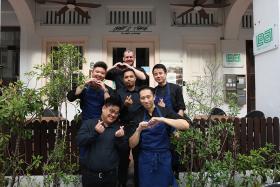Is nasi goreng from Singapore?
Ex-England football star's photo of nasi goreng sparks debate over the origins of the ubiquitous fried rice
As our eyes were fixed on the Formula 1 Singapore Airlines Singapore Grand Prix over the weekend, some Indonesian netizens were fixated on a peculiar topic - the origins of nasi goreng.
The question was raised after former England and Manchester United defender Rio Ferdinand tweeted a photo of himself eating fried rice in his hotel room on Saturday with the caption: "Nasi goreng lunch... Keeping it local in #Singapore."
This did not sit well with some Indonesian netizens, who claimed the dish as their own.
Ferdinand, 37, who was in town for the Singapore Grand Prix, clarified yesterday that by "local", he was referring to South-east Asia.

The whole debate then begs the question: Does it matter where a dish comes from?
On this matter, food critics seem to agree: It does not matter.
Mr Adam Shah, 33, who runs The Halal Food Blog, told The New Paper: "Each country has its own version of nasi goreng, it's very hard to pinpoint where it came from originally."
With the many types of fried rice around the region, TNP breaks down the differences between the more popular ones in Singapore.
INDONESIAN STYLE

"It is sweeter, has bolder flavour and is drenched in soy sauce", said owner of Warung Surabaya, Mr Budiman Leo, 34.
The eatery at Lucky Plaza sells one type of fried rice, Nasi Goreng Ayam (chicken fried rice) for $7.50.
Mr KF Seetoh, founder of Makansutra, said Indonesian-style fried rice tends to contain lamb.
CHINESE STYLE

 PHOTO: TANG TEA HOUSE
PHOTO: TANG TEA HOUSE
Unlike the sweeter Indonesian-style fried rice, Chinese-style fried rice is saltier and typically contains lard.
Mr Benjamin Aw, 27, a vegetarian stall owner at Bukit Panjang Hawker Centre who sells three types of Chinese-style fried rice, said it focuses more on creating "wok hei", or the "essence" created by stir-frying food over high heat.
Tang Tea House, which runs three outlets, said the Chinese-style fried rice is generally less spicy.
Its spokesman said: "While Indonesian-style fried rice, like Kampong Fried Rice, is spicier and more charred, the Chinese-style fried rice, such as the Yangzhou Fried Rice, is generally not spicy."
Tang Tea House sells more than seven fried rice dishes, which are all halal.
INDIAN-MUSLIM STYLE

This style of fried rice is known for its dark red colour.
"They are redder and peppered with ikan bilis (anchovies)," said Mr Shah.
Al-Azhar Eating Restaurant manager, who wanted to be known as Mr Samsudin, 49, said the redness is likely to be derived from the tomato paste they used.
Mutton and minced meat are commonly found in this style of fried rice, added Mr Samsudin.
Get The New Paper on your phone with the free TNP app. Download from the Apple App Store or Google Play Store now


